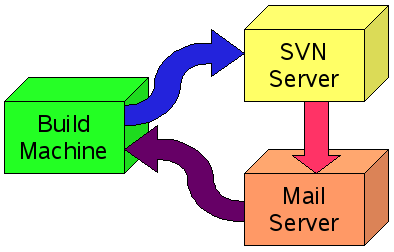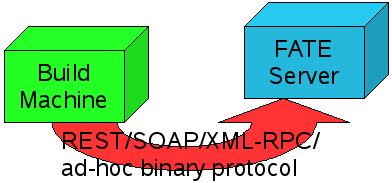People have provided a lot of useful and constructive feedback, both publicly and privately, regarding the developing FATE Server. I’m not taking every idea seriously, however. For example, several people have suggested that the build machines should trigger off of emails to the mailing list that monitors FFmpeg SVN commit messages and only check out new code and kick off new build/test cycles in response to such mails. Since the SVN server is responsible for sending the emails, the flow looks something like this:

Really, this post is merely an excuse to make more illustrations using OpenOffice’s Draw component. Anyway, the current FATE system operates by polling the SVN server periodically for updated revisions (where period=15min); it also checks again immediately after completing a full build/test cycle. In this case, I can’t justify adding the coding, debugging, and maintenance complexities of having the script poll the server somehow (or even have emails pushed via IMAP), parse the emails, and determine when to ask SVN for new source, when the periodic poll process performs peachy. Thus, one box and two arrows are eliminated from the drawing entirely.
One person who has a lot more experience in web database apps than I do was appalled that I was going the simple route by using the Python MySQLdb module to access the FATE Server’s MySQL database directly and insert new build records and test results. Hey, it’s the simplest solution, and my web provider allows me to do it.

Apparently, it’s trendier for modern apps to travel along a more circuitous route. This means, rather than use the most direct protocol, package the data in some intermediate format — often an XML-based format — and send it along an HTTP transport. Common candidates for the task include XML-RPC, REST and SOAP. Ad-hoc protocols are also possible.

At first, this went right into the ‘reject’ bin as well. I may need to rethink that, though. I am lining up helpful souls who wish to lend their own custom hardware resources to this effort so that FATE (and FFmpeg, in turn) can enjoy broader platform support. It turns out that Python-MySQLdb does not work equally well on all operating systems. Hopefully, Python’s built-in HTTP libraries will work well enough that I could build my own ad-hoc protocol (no XML, thanks) if need be.




